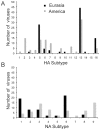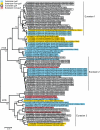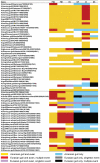Extensive geographic mosaicism in avian influenza viruses from gulls in the northern hemisphere
- PMID: 21697989
- PMCID: PMC3115932
- DOI: 10.1371/journal.pone.0020664
Extensive geographic mosaicism in avian influenza viruses from gulls in the northern hemisphere
Abstract
Due to limited interaction of migratory birds between Eurasia and America, two independent avian influenza virus (AIV) gene pools have evolved. There is evidence of low frequency reassortment between these regions, which has major implications in global AIV dynamics. Indeed, all currently circulating lineages of the PB1 and PA segments in North America are of Eurasian origin. Large-scale analyses of intercontinental reassortment have shown that viruses isolated from Charadriiformes (gulls, terns, and shorebirds) are the major contributor of these outsider events. To clarify the role of gulls in AIV dynamics, specifically in movement of genes between geographic regions, we have sequenced six gull AIV isolated in Alaska and analyzed these along with 142 other available gull virus sequences. Basic investigations of host species and the locations and times of isolation reveal biases in the available sequence information. Despite these biases, our analyses reveal a high frequency of geographic reassortment in gull viruses isolated in America. This intercontinental gene mixing is not found in the viruses isolated from gulls in Eurasia. This study demonstrates that gulls are important as vectors for geographically reassorted viruses, particularly in America, and that more surveillance effort should be placed on this group of birds.
Conflict of interest statement
Figures





References
-
- Kawaoka Y, Cox NJ, Haller O, Hongo S, Klenk H-D, et al. Orthomyxoviridae. In: Fauquet CM, Mayo MA, Maniloff J, Desselberger U, Ball LA, editors. Virus Taxonomy: Eighth Report of the International Committee for the Taxonomy of Viruses. San Diego, U.S.A.: Elsevier Academic Press; 2005. pp. 681–693.
-
- Crawford PC, Dubovi EJ, Castleman WL, Stephenson I, Gibbs EPJ, et al. Transmission of equine influenza virus to dogs. Science. 2005;310:485–485. - PubMed
-
- Kuiken T, Rimmelzwaan D, van Riel G, van Amerongen M, Baars M, et al. Avian H5N1 influenza in cats. Science. 2004;306:241. - PubMed
Publication types
MeSH terms
Associated data
- Actions
- Actions
- Actions
- Actions
- Actions
- Actions
- Actions
- Actions
- Actions
- Actions
- Actions
- Actions
- Actions
- Actions
- Actions
- Actions
- Actions
- Actions
- Actions
- Actions
- Actions
- Actions
- Actions
- Actions
- Actions
- Actions
- Actions
- Actions
- Actions
- Actions
- Actions
- Actions
- Actions
- Actions
- Actions
- Actions
- Actions
- Actions
- Actions
- Actions
- Actions
- Actions
- Actions
- Actions
- Actions
- Actions
- Actions
- Actions
Grants and funding
LinkOut - more resources
Full Text Sources
Miscellaneous

